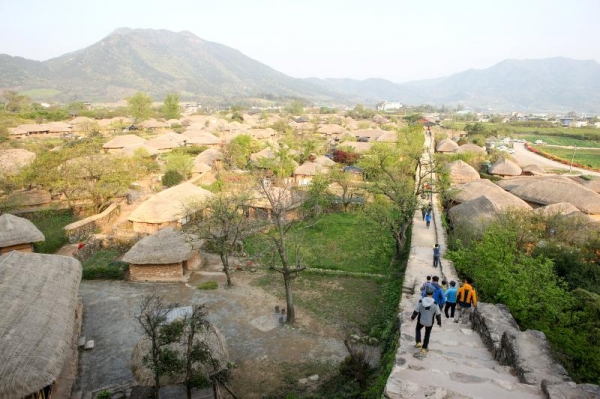"I fell in love with Korean stamps in 2017. When I first came to Korea from Costa Rica as a college freshman in 2010, I knew little about Korean history, people or tourist spots. While a student, I attended a few lectures on the nation's history and culture but didn't remember much from them.
A few years after graduation, I went to a post office to send a letter to a friend. I bought a postage stamp from the commemorative series "Beautiful Korea Definitive Stamps" featuring nine domestic landmarks including Dongbaekseom Island in Busan, Namdaemun (Sungnyemun) Gate in Seoul and Hwaseong Fortress in Suwon, Gyeonggi-do Province.
Even a tiny stamp holds a lot of information on Korea, I thought. So I decided to learn more about the country through stamps and eventually started collecting those displaying landmarks and people. This series is my introduction to Korean history and culture through stamps issued by the Korea Post."

Korea Post on Aug. 5 issued a stamp series featuring Gochang Eupseong Fortress in Gochang-gun County, Jeollabuk-do Province, Naganeupseong Folk Village in Suncheon, Jeollanam-do Province, and Haemieupseong Walled Town in Seosan, Chungcheongnam-do Province. These "three fortresses of Korea" got their nickname from being the nation's best restored and preserved structures of their kind.
An eupseong is a unique fortress for protecting the people and administrative agencies of a provincial town. When the fortresses were first built remains unknown, but they mostly started to appear in the late Goryeo Dynasty (918-1392) to block Japanese invasions on the southern coast.
During the reign of King Seongjong (1469-94) during the Joseon Dynasty (1392-1910), 190 out of 330 administrative districts were designated eupseong, with around 20 still standing such as Dongnae Eupseong, Ansan Eupseong, Gyeongju Eupseong and Namwon Eupseong. The ones depicted in the stamps are the best preserved of the bunch, thus they are called the nation's three fortresses.
Yang Si-eun, a professor at the Department of Archaeology and Art History at Chungbuk National University in Cheongju, Chungcheongbuk-do Province, said, "Government offices were located in walled towns (fortresses) and served as administrative centers handling regional administration and civil complaints during regular times. In an emergency, it was a military base to ward off foreign invasions."
Gochang Eupseong Fortress (Gochang-gun County, Jeollabuk-do Province)

Gochang Eupseong Fortress is on the roughly flattened slopes of a mountain foot. It has rocks native to the area and is 4-6 m high and 1,684 m long. The three gates are in the east, west and north, and the fortress has a barbican, two water gates to discharge water and a good defense system. Given the stonework techniques and inscriptions on stones, the fortress is believed to have been built in the late 16th century using labor mobilized from all over the province before the 1592 Japanese invasion of Korea.

Quite a few historical TV series and movies have been filmed at this fortress. "Nokdu Flower" (2019), a drama on the 1894-95 Donghak Peasant Revolution funded by Gochang-gun County, was filmed here.
Every October, this site also hosts the Gochang Moyang Fortress Festival, which offers dabseongnori, a game in which women go to a fortress and walk along the ridges in a line, and ganggangsullae, a traditional circle dance and allows guests to experience the military culture of the Joseon Dynasty.
Naganeupseong Folk Village (Nagan-myeon Township, Suncheon, Jeollanam-do Province)

Naganeupseong Folk Village is one of the nation's few towns to have fully retained the form of a traditional village.
Construction of the village began in the early Joseon Dynasty and underwent several renovations before its completion in 1626 while General Im Gyeong-eop was Nagan-gun County governor and in the fourth year of King Injo's reign.
The stone fortress is 1,420 m long, 4 m tall and 3-4 m wide on flat land and was solidly built with natural square rocks 1-2 m wide.
The main road connecting the east and west gates is a public space with inns and a government office. The south side is where commoners lived. Along the rampart are three fortress gates, bastion, barbican and moat.
Inns, government offices, prison, warehouses, a lotus pond and a place for washing clothes are well preserved inside this fortress built on flat land. The outstanding preservation of the village's old architectural beauty has made the site a popular filming site for historical TV series, including "Jewel in the Palace" (2003), "Immortal Admiral Yi Sun-sin" (2004) and "100 Days My Prince" (2018).
To get to the village from Seoul, take the KTX bullet train from Seoul Station bound for Yeosu Expo, get off at Suncheon Station and take a bus to the village. A taxi ride from Suncheon Station to the village takes about 20 minutes.
Haemieupseong Walled Town (Haemi-myeon Township, Seosan, Chungcheongnam-do Province)

Construction of Haemieupseong Walled Town began in the 18th year of King Taejong's reign (1418) and was completed about 70 years later in the 22nd year of King Seongjong's reign (1491). The fortress has a circumference of 1,800 m, the longest among the three fortresses, and a height of 5 m. This town was the headquarters of Chungcheong-do Province's military and used to defend the west coast.
To get to Seosan Bus Terminal, take an inter-city express bus (Honam Line) at Central City Terminal in Seoul. The bus ride is around two hours and after arriving at Seosan Bus Terminal, a taxi to Haemieupseong takes 20 minutes.
By Elias Molina and Lee Jihae (Korea.net)


